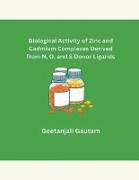- Start
- Biological Activity of Zinc and Cadmium Complexes Derived from N, O, and S Donor Ligands
Biological Activity of Zinc and Cadmium Complexes Derived from N, O, and S Donor Ligands
Angebote / Angebote:
Zn is the human body's second most abundant trace metal [1] and can catalyze over 300 enzymes, such as those responsible for the synthesis of DNA and RNA [2]. It is also physiologically essential for bone metabolism, collagen synthesis, and the integrity of the immune system, anti-inflammatory actions, and defense versus free radicals [3]. Therefore, Zn(II) is better removed by novel methods away from classical coordination methods used in vivo. Nevertheless, cadmium is a very toxic metal ion that poses both human and animal health hazards. Its toxicity is done by its easy localization inside the liver and then by the binding of metallothionein, which eventually forms a complex and is transmitted into the blood stream to be lodged in the kidney. The cause of Cd toxicity is the negative effect on cell enzyme systems that are the consequences of metallic ion substitution (mainly Zn2+, Cu2+, and Ca2+) into metalloenzymes and its strong interaction with thiol groups [4]. Zinc (II) replacement with Cd(II) ion usually causes apoprotein catalysis to break down [5, 6].
Folgt in ca. 10 Arbeitstagen
